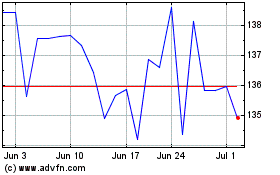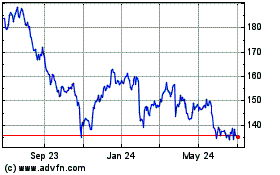UPS Posts Strong Gains as Package Volumes Swell--2nd Update
October 28 2020 - 11:35AM
Dow Jones News
By Paul Ziobro
United Parcel Service Inc. is delivering more packages, but it
is paying a much bigger price to do so.
The delivery giant said revenue rose nearly 16% in the third
quarter and profit rose 11.8% amid an influx of packages moving
domestically and internationally during the pandemic. Despite the
boost, UPS's large domestic business posted a sharp decline in
profits due to the need to hire tens of thousands of new workers,
lower margins from delivering packages to homes and $179 million in
spending to speed up delivery times.
The decline in U.S. profits and continued higher costs heading
into the holiday season weighed on shares, which fell more than 5%
in early trading amid a broader market selloff. They are still up
nearly 40% for the year.
The results put added pressure on new Chief Executive Carol Tomé
to operate UPS as "better, not bigger" by solving the problem of
how to handle the shift to e-commerce, which was accelerated by the
pandemic, more profitably.
"Continued compression in domestic margins means that the debate
over whether UPS has 'fixed' e-commerce remains open," Bernstein
transportation analyst David Vernon said in a research note.
Ms. Tomé, a former Home Depot Inc. finance chief and longtime
UPS board member, is focusing on cutting costs and reining in
spending while raising shipping rates and getting more business
from higher-margin customers like smaller businesses and the
health-care industry.
She is trying to do it at a larger scale than the company had
done in the past, including speeding up decisions by cutting the
number of committees running the business to six from 21.
"In the past, we did it by increments," she said on Wednesday's
earnings call. "We're now doing it in a meaningful way."
The decline in U.S. profits was offset by big gains in UPS's
other segments. Its international business posted a 12% increase in
shipping volumes and a 45% jump in profits, as a reduction in
passenger flights that normally handle cargo has given shippers
fewer options.
The smaller supply chain and freight division posted a 22%
profit increase due to strong shipping demand out of Asia.
Both FedEx and UPS have benefited from the global shipping
environment, which has tightened international freight capacity and
provided more packages to deliver as more people shop online. The
boom in the number of packages has overwhelmed their delivery
networks and stretched delivery times, but the demand has given the
carriers leeway to impose fees and negotiate higher rates from
shippers.
The shipping volume is expected to remain robust during the
holiday season. Both FedEx and UPS have warned their largest
customers that there is no extra capacity available during the busy
shipping period, while other smaller carriers have stopped taking
new customers until next year.
Ms. Tomé said that the shipping industry is facing "capacity
constraints" for the holiday season and that UPS is working closely
with retailers on the timing of their promotions and using tools
like more automated capacity, faster shipping times and weekend
services to manage through.
"We are projecting a pretty peaky peak," Ms. Tomé said. "While
we expect this holiday season to have its challenges, we are ready
to deliver a successful peak."
Write to Paul Ziobro at Paul.Ziobro@wsj.com
(END) Dow Jones Newswires
October 28, 2020 11:20 ET (15:20 GMT)
Copyright (c) 2020 Dow Jones & Company, Inc.
United Parcel Service (NYSE:UPS)
Historical Stock Chart
From Mar 2024 to Apr 2024

United Parcel Service (NYSE:UPS)
Historical Stock Chart
From Apr 2023 to Apr 2024
